Arctostaphylos hooveri
Leafl. W. Bot. 9: 152. 1961 ,.
Shrubs or trees, erect, 2–8 m; burl absent; twigs densely fine-hairy, with long, white, gland-tipped hairs. Leaves: petiole 3–6 mm; blade glaucous, dull, oblong to ovate, 4–6 × 2–3 cm, base lobed, auriculate, (not clasping), margins entire, plane, surfaces papillate, scabrous, glandular-hairy, ± glabrescent. Inflorescences panicles, 4–6-branched; immature inflorescence pendent, (concealed by bracts), axis 1.5–2.5 cm, 1+ mm diam., densely fine-hairy with long, white, gland-tipped hairs; bracts not appressed, leaflike, lanceolate, 8–20 mm, apex acuminate, surfaces glandular-hairy. Pedicels 8–15 mm, finely glandular-hairy. Flowers: corolla white, conic to urceolate; ovary finely glandular-hairy. Fruits depressed-globose, 6–10 mm diam., glandular-hairy, (viscid). Stones distinct. 2n = 26.
Phenology: Flowering winter–early spring.
Habitat: Chaparral, open conifer forests
Elevation: 900-1200 m
Discussion
Of conservation concern.
Arctostaphylos hooveri is known from the northern Santa Lucia Mountains in Monterey County. Populations are associated with openings in yellow pine forests and patches of chaparral.
Selected References
None.
Lower Taxa
"entire" is not a number.
